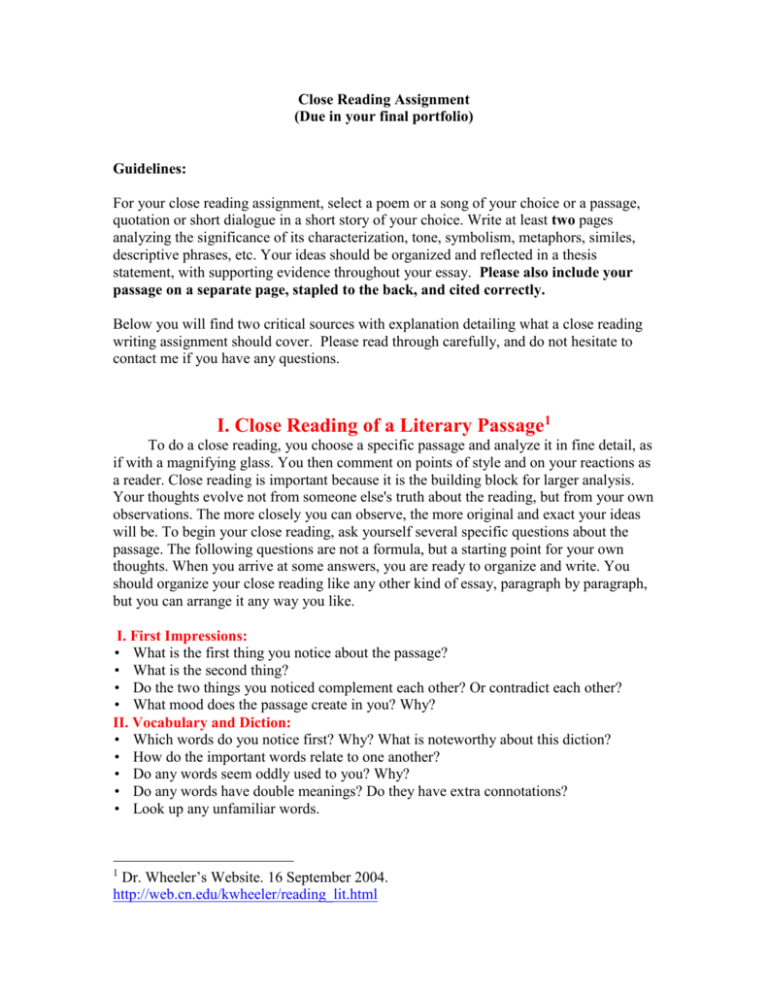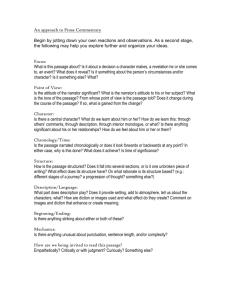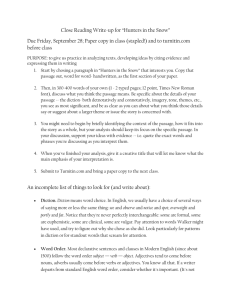Introduction to Close Reading
advertisement

Close Reading Assignment (Due in your final portfolio) Guidelines: For your close reading assignment, select a poem or a song of your choice or a passage, quotation or short dialogue in a short story of your choice. Write at least two pages analyzing the significance of its characterization, tone, symbolism, metaphors, similes, descriptive phrases, etc. Your ideas should be organized and reflected in a thesis statement, with supporting evidence throughout your essay. Please also include your passage on a separate page, stapled to the back, and cited correctly. Below you will find two critical sources with explanation detailing what a close reading writing assignment should cover. Please read through carefully, and do not hesitate to contact me if you have any questions. I. Close Reading of a Literary Passage1 To do a close reading, you choose a specific passage and analyze it in fine detail, as if with a magnifying glass. You then comment on points of style and on your reactions as a reader. Close reading is important because it is the building block for larger analysis. Your thoughts evolve not from someone else's truth about the reading, but from your own observations. The more closely you can observe, the more original and exact your ideas will be. To begin your close reading, ask yourself several specific questions about the passage. The following questions are not a formula, but a starting point for your own thoughts. When you arrive at some answers, you are ready to organize and write. You should organize your close reading like any other kind of essay, paragraph by paragraph, but you can arrange it any way you like. I. First Impressions: • What is the first thing you notice about the passage? • What is the second thing? • Do the two things you noticed complement each other? Or contradict each other? • What mood does the passage create in you? Why? II. Vocabulary and Diction: • Which words do you notice first? Why? What is noteworthy about this diction? • How do the important words relate to one another? • Do any words seem oddly used to you? Why? • Do any words have double meanings? Do they have extra connotations? • Look up any unfamiliar words. Dr. Wheeler’s Website. 16 September 2004. http://web.cn.edu/kwheeler/reading_lit.html 1 III. Discerning Patterns: • Does an image here remind you of an image elsewhere in the book? Where? What's the connection? • How might this image fit into the pattern of the book as a whole? • Could this passage symbolize the entire work? Could this passage serve as a microcosm--a little picture--of what's taking place in the whole work? • What is the sentence rhythm like? Short and choppy? Long and flowing? Does it build on itself or stay at an even pace? What is the style ike? • Look at the punctuation. Is there anything unusual about it? • Is there any repetition within the passage? What is the effect of that repetition? • How many types of writing are in the passage? (For example, narration, description, argument, dialogue, rhymed or alliterative poetry, etc.) • Can you identify paradoxes [a seemingly contradictory statement that may nonetheless be true] in the author's thought or subject? • What is left out or kept silent? What would you expect the author to talk about that the author avoided? IV. Point of View and Characterization: • How does the passage make us react or think about any characters or events within the narrative? • Are there colors, sounds, physical description that appeals to the senses? Does this imagery form a pattern? Why might the author have chosen that color, sound or physical description? • Who speaks in the passage? To whom does he or she speak? Does the narrator have a limited or partial point of view? Or does the narrator appear to be omniscient, and he knows things the characters couldn't possibly know (for example, future historical events, events taking place "off stage," the thoughts and feelings of multiple characters, and so on). V. Symbolism: • Are there metaphors? What kinds? • Is there one controlling metaphor? If not, how many different metaphors are there, and in what order do they occur? How might that be significant? • How might objects represent something else? • Do any of the objects, colors, animals, or plants appearing in the passage have traditional connotations or meaning? What about religious or biblical significance? II. Close reading - Checklist2 Grammar The relationships of the words in sentences. Vocabulary The author's choice of individual words. Figures of speech The rhetorical devices used to give decoration and imaginative expression to literature, such as simile or metaphor. Literary devices The devices commonly used in literature to give added depth to the work, such as imagery or symbolism. Tone The author's attitude to the subject as revealed in the manner of the writing. Style The author's particular choice and combination of all these features of writing which creates a recognizable and distinctive manner of writing. 2 Mantax. 16 September 2004. http://www.mantex.co.uk/samples/closeread.htm








